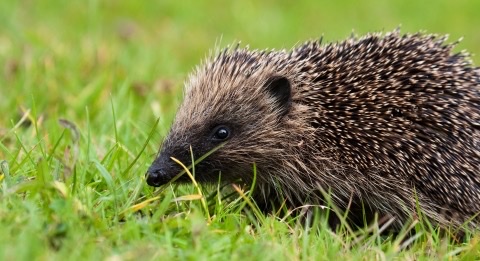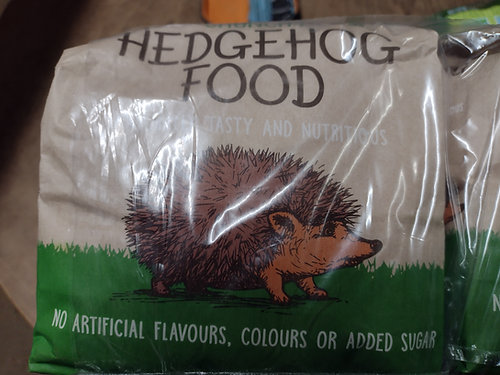Hedgehogs are charismatic creatures that are well-loved by all. However, there have been large declines all across the country, with a third of all our hedgehogs lost since the millennium, they are now classed as vulnerable!
There are 17 species of hedgehogs across the world. Our native hedgehogs (Erinaceus europaeus) hibernate in the winter months to conserve energy and wake up around March - April, breeding from June - August, producing 4-8 young. From September, they will try to eat as much as possible in preparation for hibernation. They have a huge appetite and eat all sorts of insects; worms, beetles, snails, slugs and beetles, but also plants and small mammals!
If you are unsure whether you have hedgehogs living nearby, remember they are most active at night, therefore look out for trails they may regularly follow - leaving little tunnel tracks in grass, shrubs or hedges, footprints, poo and any noise you may hear when it gets dark.
Gardens are now some of the largest habitats for them, as well as hedgerows and woodlands. Small changes to your own garden can make a huge difference to your local population. Here are some of the most important changes you can make to do your bit to help our hedgehogs...
1 - Hedgehog highway! You can help them by making sure there is a small hole in your garden fencing that allows them to pass through! They have been known to travel up to 2 miles a night and secure gardens make these areas inaccessible and difficult for them to move about in urban areas.
A hole 13cm - 13cm is big enough for any hedgehog, but should be small enough that pets can't get through. Even better would be to have hedges that will not only benefit the hedgehogs, but the birds and insects too.
How to create a hedgehog hole:
Photo credit: https://www.jacksons-fencing.co.uk/hedgehog-fencing
2 - Feeding! You can also place hedgehog food out if you know there are some individuals nearby. Make sure you put out food that is ok for hedgehogs to eat and won't make them poorly. For example, it is not advisable to feed them dairy products, vegetables or any kind of processed, cooked or raw meat. We sell hedgehog food which is perfect for this, to find out more, follow this link:
To prevent other animals and pets from eating the food, a feeding station can help. This can be as simple as a big box weighed down and with a small 13cm - 13cm hole which will allow hedgehogs access, but not larger animals. It may take some time for the hedgehogs to get used to the food being there, so don't give up on the first few times you try!
Make sure a fresh supply of water is available too, which can be used by other wildlife as well.
What to feed Hedgehogs:
3 - Watch where they sleep! When lighting bonfires outside or digging up compost heaps, make sure to check underneath, as hedgehogs may have made a nest in there! This is especially crucial during the winter months when they may be hibernating, but also during the day when they may be resting. Using fencing or moving the heap before lighting can make sure no hedgehogs are in there.
4 - Pesticides! When protecting your plants in your garden, avoid using slug pellets and other pesticides that hedgehogs may eat or indirectly eat through consuming slugs. Instead, there are many alternative ways of handling garden pests that won't kill hedgehogs such as copper strips or nematodes as sold here:
5 - Hedgehog house! If you're really up to the challenge of helping your local hedgehogs, why not build them a hedgehog house! This can be the perfect place for them to safely hibernate or where a mother may bring up her hoglets in the summer. There's a lot of help online on what they require from a house or why not buy one as a gift for a friend?
How to build a hedgehog home:
6 - Hazards! Your garden may not seem particularly dangerous, but to a hedgehog it could be fatal. For example, they may get tangled up in spare netting or litter. Also, checking long grass before mowing is a really simple way of making sure no hedgehogs are harmed, as they won't run away like some animals and will curl up in a defensive ball instead.
7 - Ponds! Make sure ponds and other steep sided areas like cattle grids have some form of ramp for hedgehogs to climb out else they can get stuck. Anything from bricks to wood will make an ideal ramp. Make sure drain covers are securely on too.
Wildlife-friendly pond ideas:
8 - Roads! If you have found hedgehogs in your area and live near a road, make sure to be wary when driving of them out and about at night. It may even be a good idea to put a hedgehog sign out to warn road users. By making a hole in your garden fence, you may reduce the need for hedgehogs to go near roads.
9 - Keep it wild! Why have a pristine garden when you can have hedgehogs attracted to live there? Keeping areas slightly more wild - with twigs, leaves and logs are great for hedgehogs to nest in and find food.
10 - Join a group! Your local area may already have a hedgehog community set up so be sure to get involved! You can also sign up with Hedgehog street:
If you happen to come across a hedgehog that doesn't seem to be completely happy or healthy, it may need some help. The best course of action is to ring your local wildlife rescue centre that can give you the best advice.
What to do if you find a poorly hedgehog:
It's always a magical experience when you find a hedgehog just outside your door, so be sure to keep an eye out for them, as well as an ear - they're quite noisy when they're snuffling around!
Other useful links:
Hedgehog factsheet with 24 hour emergency helpline:
References:














Opmerkingen